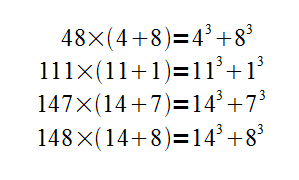- Jimmy Carter was the first U.S. president born in a hospital.
- Hamlet has 1506 lines, fully 39 percent of the play.
- 736 = 7 + 36
- NOOK combines two antonyms.
- “Everything that deceives may be said to enchant.” — Plato
Science & Math
Symmetric Milestones
What’s unusual about these numbers?

Each series is spaced evenly on the number line:

Each number is a palindrome.
And each is prime.
Education Reconsidered
Reflect, Socrates; you may have to deny your words.
I have reflected, I said; and I shall never deny my words.
Well, said he, and so you say that you wish Cleinias to become wise?
Undoubtedly.
And he is not wise as yet?
At least his modesty will not allow him to say that he is.
You wish him, he said, to become wise, and not to be ignorant?
That we do.
You wish him to be what he is not, and no longer to be what he is?
I was thrown into consternation at this.
Taking advantage of my consternation he added: You wish him no longer to be what he is, which can only mean that you wish him to perish. Pretty lovers and friends they must be who want their favourite not to be, or to perish!
— Plato, Euthydemus
Math Notes
9 + 9 = 18; 9 × 9 = 81
24 + 3 = 27; 24 × 3 = 72
47 + 2 = 49; 47 × 2 = 94
497 + 2 = 499; 497 × 2 = 994
Two Milestones
The date 11/19/1999 contained only odd digits. Less than three months later, 2/2/2000 contained only even.
That’s a rare coincidence. It had been 1111 years since the last all-even date … and it’ll be 1111 more before the next all-odd one.
Skyward
In 1907, Massachusetts physician Duncan MacDougall conceived a singular experiment. When he observed that a patient at his Haverhill hospital was nearing death, he installed him in a specially constructed bed in his office and measured his weight both before and after death. With six such weighings he determined that humans lose between 0.5 and 1.5 ounces at death.
“Is the soul substance?” he wrote. “It would seem to me to be so. … Here we have experimental demonstration that a substance capable of being weighed does leave the human body at death.”
Similar experiments with 15 dogs showed no change in mass, proving, he decided, that dogs have no souls. MacDougall’s findings were written up briefly in the New York Times and occasioned a flurry of correspondence in American Medicine, but after that they were largely forgotten. But who knows? Perhaps he was right.
Math Notes

Pop Physics
A can of Diet Coke floats in water, while regular Coke sinks:
Why? The Diet Coke contains 190 mg of aspartame, but the regular Coke contains 39 grams of sugar. So the regular Coke is denser.
E Pluribus Unum
111111111111111111111111111111111111111111111111111111111111111111111111111111111111111111 111111111111111111111111111111111111111111111111111111111111111111111111111111111111111111
111111111111111111111111111111111111111111111111111111111111111111111111111111111111111111
111111111111111111111111111111111111111111111111111111111111111111111111111111111111111111
111111111111111111111111111111111111111111111111111111111111111111111111111111111111111111
111111111111111111111111111111111111111111111111111111111111111111111111111111111111111111
111111111111111111111111111111111111111111111111111111111111111111111111111111111111111111
111111111111111111111111111111111111111111111111111111111111111111111111111111111111111111
111111111111111111111111111111111111111111111111111111111111111111111111111111111111111111
111111111111111111111111111111111111111111111111111111111111111111111111111111111111111111
111111111111111111111111111111111111111111111111111111111111111111111111111111111111111111
11111111111111111111111111111111111111111 is prime.
Market Forces
The following question was a favourite topic for discussion, and thousands of the acutest logicians, through more than one century, never resolved it: ‘When a hog is carried to market with a rope tied about its neck, which is held at the other end by a man, whether is the hog carried to market by the rope or the man?’
— Isaac Disraeli, Curiosities of Literature, 1893
